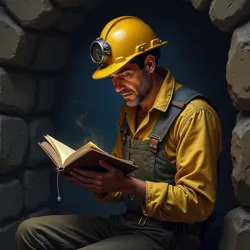Subterranean Chapbooks

Compact booklets serving as vital conduits for folklore and knowledge in the Underdark, reflecting the unique culture of subterranean societies.
conduits for folklore, knowledge, commentary, entertainment
Fungal Parchment, obsidian, stone
accessible to miners, artisans, travelers
folklore, practical knowledge, satire
oral traditions and nascent literacy
Underdark
chapbooks of surface societies
*Subterranean chapbooks* are a distinct form of printed literature that flourished within the sunless realms of the Underdark. Emerging from the oral traditions and nascent literacy of subterranean cultures, these compact, easily disseminated booklets served as vital conduits for folklore, practical knowledge, social commentary, and entertainment amongst the diverse populations dwelling beneath the surface world. Analogous in function to the chapbooks of surface societies, yet uniquely adapted to the subterranean environment and its inhabitants, subterranean chapbooks represent a significant chapter in the evolution of Underdark Folklore and literary expression. They are not merely miniature books but rather cultural artifacts that reflect the specific needs, values, and artistic sensibilities of the communities that produced and consumed them.
Unlike the grand illuminated scrolls often commissioned by noble houses or wealthy patrons, subterranean chapbooks were characterized by their accessibility and affordability, making them available to a wider spectrum of Underdark society, including miners, artisans, travelers, and even certain segments of the rigid Drow Society. Their portability allowed for easy transport through the labyrinthine tunnels and caverns of the Underdark, facilitating the spread of information and narratives across disparate settlements and cultural boundaries. Subterranean chapbooks are more than just printed material; they are tangible embodiments of the Underdark's cultural dynamism, reflecting the interplay between tradition and innovation, secrecy and dissemination, darkness and illumination.
Origins and Evolution
The genesis of subterranean chapbooks is intrinsically linked to the gradual transition from purely oral traditions to written forms of communication within the Underdark. For centuries, the folklore, histories, and practical knowledge of subterranean cultures were primarily transmitted through spoken word, performance, and ritual. However, the rise of literacy, particularly amongst the Nigritude Gnomes and certain scholarly enclaves within other subterranean societies, created a demand for more permanent and widely distributable forms of recorded information. Subterranean chapbooks arose as a direct response to this need, providing a bridge between the ephemeral nature of oral storytelling and the enduring presence of written texts.
 Artisans crafting fungal parchment from Underdark fungi, a durable and flexible material used for subterranean chapbook pages.
Artisans crafting fungal parchment from Underdark fungi, a durable and flexible material used for subterranean chapbook pages.From Oral Tradition to Written Form
The shift from oral tradition to written chapbooks was not an abrupt replacement but rather a gradual and symbiotic evolution. Oral storytelling remained a vibrant and essential part of Underdark culture, even as chapbooks gained popularity. In many ways, chapbooks served to augment and diversify oral traditions, rather than supplanting them entirely. Early chapbooks often drew directly from existing oral narratives, transcribing popular folktales, ballads, and moral fables that had been passed down through generations. These initial written versions often retained the stylistic elements and narrative structures of oral storytelling, reflecting their origins in the spoken word.
The act of reading chapbooks aloud became a form of performance in itself, echoing the communal and interactive nature of oral storytelling sessions. Traveling performers and storytellers would often utilize chapbooks as prompts or mnemonic aids, reciting familiar tales from the written page while adding their own improvisations and embellishments, thus maintaining the dynamic and evolving character of Underdark folklore. This interplay between written and oral forms ensured that chapbooks did not become static or ossified texts, but rather remained fluid and adaptable cultural artifacts, constantly reinterpreted and reimagined in each performance and reading.
Materials and Production
The unique environment of the Underdark dictated the materials and production methods employed in the creation of subterranean chapbooks. Surface-derived paper and parchment were scarce and vulnerable to the damp and often cavernous conditions of the Underdark. As a result, subterranean artisans developed ingenious alternatives, utilizing materials readily available within their subterranean world. The most prevalent material for chapbook pages became Fungal Parchment, a substance derived from specially cultivated and treated Underdark fungi. This material, when properly processed, possessed a remarkable durability, flexibility, and resistance to moisture, making it ideally suited for subterranean use.
The production of fungal parchment was a specialized craft, often practiced by guilds or families who guarded their techniques closely. Various types of fungi, such as the Agaricus cavernicola and the Lycoperdon subterraneum, were favored for their specific properties. The fungal matter was carefully harvested, treated with alchemical solutions derived from subterranean minerals, and then pressed and dried into thin, pliable sheets resembling parchment. The quality and texture of fungal parchment could vary depending on the type of fungus used, the processing methods employed, and the skill of the artisan, leading to a range of grades and styles of chapbooks.
In addition to fungal parchment, some subterranean chapbooks, particularly those produced by wealthier patrons or for more durable purposes, utilized thin sheets of polished obsidian or other locally sourced stone materials. These stone pages were considerably more laborious to produce and less flexible than fungal parchment but offered exceptional durability and resistance to the harsh conditions of the Underdark. Inks used for printing or writing on chapbooks were typically derived from mineral pigments, bioluminescent fungi, or processed cave lichen, resulting in a palette of earthy tones, luminous shades, and enduring colors that reflected the subterranean environment itself. The printing process, when employed, often involved carved wooden blocks or meticulously crafted stone stamps, allowing for the reproduction of text and simple illustrations on the prepared pages.
Dissemination and Accessibility
Subterranean chapbooks, unlike the more exclusive illuminated scrolls, were designed for wider dissemination and accessibility. Their compact size, relatively low production cost (especially those made with fungal parchment), and portability made them ideal for trade and distribution throughout the Underdark. Traveling merchants, miners moving between settlements, and even adventurous explorers would often carry bundles of chapbooks to exchange or sell in different communities, facilitating the spread of information, stories, and cultural trends across vast subterranean distances.
The relatively lower cost of production, compared to scrolls or larger volumes, made chapbooks accessible to a broader spectrum of Underdark society. While literacy rates varied across different cultures and social strata, chapbooks provided an entry point into written literature for individuals who might not have had access to more expensive or elaborate texts. In some Underdark settlements, chapbooks were even made available in communal reading spaces or public areas, further enhancing their accessibility and promoting literacy within the community. The widespread circulation of subterranean chapbooks played a crucial role in fostering a sense of shared cultural identity and interconnectedness amongst the diverse and geographically dispersed populations of the Underdark.
Content and Themes
The content of subterranean chapbooks was remarkably diverse, reflecting the multifaceted needs and interests of Underdark communities. While folklore and narrative traditions formed a significant portion of chapbook content, they also served as vehicles for practical knowledge, instructional guides, social commentary, satire, and even rudimentary forms of news dissemination. The themes explored in subterranean chapbooks often resonated with the unique challenges and opportunities of subterranean existence, reflecting the anxieties, aspirations, and cultural values of Underdark inhabitants.
 An Underdark miner reading a chapbook about mining techniques, highlighting the practical knowledge shared through these booklets.
An Underdark miner reading a chapbook about mining techniques, highlighting the practical knowledge shared through these booklets.Folklore and Narrative Traditions
A significant portion of subterranean chapbooks was dedicated to preserving and disseminating Underdark folklore and narrative traditions. These chapbooks contained transcriptions of popular folktales, myths, legends, ballads, and epic poems that had long been part of the oral storytelling repertoire of various Underdark cultures. The tales of Claus Jabbers and his Pheromone Philtres, for instance, found early written expression in subterranean chapbooks, contributing to their wider dissemination and enduring popularity. Chapbooks allowed for the standardization and preservation of these narratives, ensuring their transmission across generations and geographical distances.
These folklore chapbooks often featured recurring themes common to Underdark storytelling, such as the dangers of the labyrinthine Underdark, encounters with strange and wondrous creatures, the allure of the unknown, and the importance of cunning and resilience in the face of adversity. Moral fables and cautionary tales were also prevalent, imparting lessons about social conduct, ethical behavior, and the consequences of both virtuous and malevolent actions. Illustrations, often rudimentary but evocative, frequently accompanied the text, enhancing the narratives' visual appeal and aiding in comprehension, particularly for those with limited literacy.
Practical Knowledge and Instruction
Beyond folklore, subterranean chapbooks served as invaluable repositories of practical knowledge and instructional guides relevant to Underdark life. Mining techniques, alchemical recipes, guides to identifying edible and poisonous fungi, maps of known cave systems, and instructions for crafting subterranean tools and implements were all common subjects found in chapbooks. These practical guides often combined empirical observation with traditional wisdom, reflecting the accumulated knowledge of generations of Underdark inhabitants.
For example, a chapbook titled "The Miner's Companion" might contain detailed instructions on safe mining practices, techniques for identifying valuable mineral deposits, warnings about cave-ins and subterranean hazards, and even folklore related to mining spirits and subterranean omens. Another chapbook, "The Alchemist's Pocket Formulary," might offer simplified versions of alchemical recipes for common potions, remedies, and crafting materials, making alchemical knowledge more accessible to a wider audience beyond formally trained alchemists. These practical chapbooks played a crucial role in disseminating essential skills and knowledge, contributing to the self-sufficiency and resilience of Underdark communities.
Satire and Social Commentary
Subterranean chapbooks also provided a platform for satire, social commentary, and the expression of dissenting viewpoints within Underdark societies. Their relatively low cost and ease of production made them a less easily controlled medium compared to official scrolls or sanctioned publications, allowing for the circulation of subversive or critical content. Satirical chapbooks often lampooned the foibles of authority figures, the excesses of the wealthy, or the rigidities of social hierarchies, employing humor and wit to critique societal norms and power structures.
In Drow society, for instance, where overt dissent was often dangerous, satirical chapbooks might subtly critique the matriarchal hierarchy or the machinations of noble houses through allegorical tales or humorous anecdotes. Gnome communities, known for their intellectual curiosity and penchant for social experimentation, might produce chapbooks that debated philosophical ideas, proposed alternative social models, or satirized the perceived absurdities of surface-world customs. These satirical and socially critical chapbooks, while often circulating in clandestine or semi-public channels, played a vital role in fostering social discourse, challenging established norms, and contributing to the dynamic evolution of Underdark cultures.
Cultural Significance and Impact
Subterranean chapbooks held profound cultural significance within the Underdark, extending far beyond their function as mere printed texts. They served as crucial instruments for cultural preservation, social cohesion, and the articulation of Underdark identities. Their impact resonated across various aspects of subterranean life, from the preservation of history and folklore to the shaping of social and political discourse, and the fostering of artistic and literary expression.
 Chapbooks playing a crucial role in preserving Underdark culture and history, acting as decentralized repositories of heritage.
Chapbooks playing a crucial role in preserving Underdark culture and history, acting as decentralized repositories of heritage.Preservation of Culture and History
One of the most significant contributions of subterranean chapbooks was their role in preserving and transmitting Underdark culture and history across generations. By providing a tangible and relatively permanent medium for recording oral traditions, historical accounts, and cultural values, chapbooks helped to safeguard the collective memory of Underdark societies. In a world often characterized by impermanence and the ever-present threat of loss or decay, chapbooks offered a sense of continuity and enduring legacy.
Chapbooks preserved not only grand narratives and epic tales but also the everyday experiences, beliefs, and customs of ordinary Underdark inhabitants. They documented local traditions, regional dialects, and specific cultural practices that might have been lost or forgotten in the absence of written records. For communities that lacked formal institutions of historical preservation or centralized archives, chapbooks served as decentralized repositories of cultural heritage, ensuring that the stories and wisdom of the past remained accessible to present and future generations.
Social and Political Influence
Subterranean chapbooks, despite their modest format, wielded considerable social and political influence within Underdark communities. They served as vital channels for disseminating information, shaping public opinion, and mobilizing social movements. In societies where formal news networks were limited or non-existent, chapbooks could rapidly spread news of events, announcements, or political developments across geographically dispersed settlements.
Political chapbooks, often produced in times of social unrest or political contention, could serve as powerful tools for propaganda, persuasion, and the articulation of alternative political viewpoints. They could rally support for specific causes, denounce perceived injustices, or promote social reforms. While official authorities might attempt to control or suppress the circulation of certain chapbooks, their decentralized production and ease of dissemination often made such efforts difficult to fully effective. The accessibility and affordability of chapbooks empowered ordinary Underdark inhabitants to participate in social and political discourse, contributing to a more dynamic and participatory public sphere.
Artistic and Literary Merit
Beyond their informational and social functions, subterranean chapbooks also possessed artistic and literary merit in their own right. Many chapbooks were not merely utilitarian texts but rather carefully crafted works of art and literary expression. Skilled scribes, artists, and printers collaborated to produce chapbooks that were visually appealing, stylistically refined, and narratively engaging.
Illustrations, borders, and decorative elements often adorned chapbook pages, enhancing their aesthetic appeal and adding layers of visual meaning to the text. Writers and poets employed literary techniques such as rhyme, rhythm, metaphor, and allegory to create chapbooks that were not only informative but also emotionally resonant and aesthetically pleasing. Ballads, poems, and fictional narratives published in chapbook form contributed to the development of distinct subterranean literary traditions, showcasing the creative ingenuity and artistic sensibilities of Underdark cultures. Subterranean chapbooks, therefore, represent a significant chapter in the history of Underdark art and literature, demonstrating that even in the sunless depths, beauty and creative expression could flourish in unexpected forms.
Comparison to Scrolls and Other Media
Subterranean chapbooks occupied a distinct niche within the broader landscape of Underdark media and communication, differing in significant ways from other forms such as illuminated scrolls and oral performance traditions. Understanding these distinctions highlights the unique characteristics and specific functions of chapbooks within the context of Underdark culture.
Chapbooks vs. Scrolls
Illuminated scrolls, while also serving as a medium for written communication in the Underdark, stood in stark contrast to chapbooks in terms of format, production, purpose, and audience. Scrolls were typically much larger and more elaborate than chapbooks, often consisting of long strips of fungal parchment or meticulously prepared stone sheets joined together to form a continuous roll. Their production was labor-intensive and costly, often involving skilled scribes, illuminators, and specialized materials.
Scrolls were primarily commissioned by wealthy patrons, noble houses, or religious institutions for purposes that demanded permanence, prestige, and elaborate presentation. They were used to record official histories, religious scriptures, legal codes, genealogical records, and other documents of high importance and enduring value. Their ornate illuminations, often featuring intricate artwork, precious pigments, and even embedded gemstones, further enhanced their status as objects of wealth and authority. In contrast, chapbooks were designed for affordability, portability, and wider circulation, catering to a broader audience and serving more diverse and everyday communicative needs. While scrolls represented official authority and elite culture, chapbooks embodied popular culture, accessibility, and grassroots communication within the Underdark.
Chapbooks and Oral Performance
Subterranean chapbooks existed in a dynamic and symbiotic relationship with oral performance traditions, rather than replacing or supplanting them. As mentioned earlier, chapbooks often drew directly from oral narratives, transcribing and disseminating folktales, ballads, and other forms of spoken word literature. Conversely, oral performers frequently utilized chapbooks as source material, prompts, or mnemonic aids, incorporating written texts into their performances while retaining the improvisational and interactive elements of oral storytelling.
Chapbooks and oral performances often complemented each other in cultural events and communal gatherings. Storytellers might recite tales from chapbooks during public performances, while audiences could purchase chapbook copies to take home and reread or share with others. Chapbooks could also serve as scripts or librettos for theatrical performances, puppet shows, or musical presentations, blending written text with live performance elements. This interplay between written and oral forms enriched the cultural landscape of the Underdark, fostering a dynamic exchange between textual and performative modes of communication.
Chapbooks in a Digital Age
While the concept of a "digital age" may seem anachronistic in the context of the Underdark, it is conceivable to imagine how the function and form of subterranean chapbooks might evolve with the introduction of new technologies or alternative communication media. If, for instance, a form of subterranean network or communication system were to emerge (perhaps utilizing bioluminescent fungi or some other Underdark-specific technology), the role of chapbooks might adapt to this new landscape.
In such a scenario, chapbooks might transition from purely physical booklets to hybrid forms, perhaps incorporating embedded bioluminescent elements, micro-engraved stone tablets, or even some form of magically encoded data storage. The content of chapbooks might also evolve to include interactive elements, hyperlinks (in a metaphorical sense), or multimedia components. While the fundamental purpose of chapbooks – to disseminate information, stories, and cultural expressions in an accessible and portable format – might remain constant, the specific form and modes of delivery could adapt to incorporate new technologies and communication paradigms, ensuring their continued relevance in a changing Underdark environment.
Examples and Notable Chapbooks
While physical examples of subterranean chapbooks are rare and often fragmented due to the challenging conditions of the Underdark environment, historical records and literary references provide glimpses into the types of chapbooks that circulated and the impact they had on Underdark cultures. Fictional titles and descriptions can further illuminate the diverse content and purposes of these subterranean booklets.
The Miner's Guide to the Deep Earth
"The Miner's Guide to the Deep Earth" represents a category of practical chapbooks focused on disseminating essential knowledge for subterranean survival and resource extraction. Such a chapbook would likely contain detailed instructions on safe mining techniques, methods for identifying valuable mineral veins, warnings about geological hazards, and remedies for common mining ailments. It might also include maps of known cave systems, charts of mineral properties, and folklore related to mining spirits and subterranean omens.
Illustrations within "The Miner's Guide" could depict different types of rock formations, diagrams of mining tools and techniques, or visual guides to identifying edible and poisonous fungi encountered in subterranean tunnels. The language would be practical and direct, aimed at miners and those involved in subterranean resource extraction, emphasizing safety, efficiency, and the accumulated wisdom of experienced Underdark miners. Such chapbooks would have been invaluable tools for miners, contributing to their safety, productivity, and collective knowledge.
The Ballads of Shadowfen
"The Ballads of Shadowfen" exemplifies the genre of folklore chapbooks, dedicated to preserving and disseminating Underdark narrative traditions. This fictional chapbook might contain a collection of ballads, poems, and songs originating from the Shadowfen region of the Underdark, a hypothetical area known for its eerie landscapes, mysterious creatures, and haunting folklore. The ballads themselves could recount tales of legendary heroes, tragic love stories, encounters with shadow creatures, or allegorical narratives exploring themes of darkness, mystery, and the allure of the unknown.
Illustrations within "The Ballads of Shadowfen" might depict scenes from the ballads, portraits of legendary figures, or evocative representations of the Shadowfen landscape and its inhabitants. The language would be lyrical and evocative, employing rhyme, rhythm, and figurative language to capture the atmosphere and emotional resonance of the ballads. Such chapbooks would have served to preserve and celebrate the unique folklore and artistic traditions of specific Underdark regions, contributing to the cultural diversity and richness of subterranean storytelling.
Jabber's Jestbook
"Jabber's Jestbook" represents the satirical and socially critical genre of subterranean chapbooks, potentially even directly referencing the figure of Claus Jabbers. This fictional chapbook might contain a collection of humorous anecdotes, satirical tales, witty sayings, and social lampoons, perhaps even featuring fictionalized accounts of Claus Jabbers' exploits and his subversive interactions with Drow society. The jestbook could satirize the foibles of authority figures, the absurdities of social customs, or the hypocrisies of various Underdark cultures, using humor and wit to critique and challenge established norms.
Illustrations within "Jabber's Jestbook" might be caricatures of social types, humorous depictions of everyday life in the Underdark, or satirical allegories of political events. The language would be witty, irreverent, and often subversive, employing wordplay, irony, and exaggeration to create humorous and thought-provoking content. Such chapbooks would have provided a platform for social commentary, dissenting voices, and the expression of alternative perspectives, contributing to the dynamic and often subversive undercurrents of Underdark cultural discourse.
Through these diverse examples, it becomes evident that subterranean chapbooks were far more than just miniature books. They were vital cultural artifacts, reflecting the ingenuity, creativity, and resilience of Underdark societies, and playing a crucial role in shaping the subterranean world and its enduring folklore.